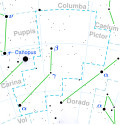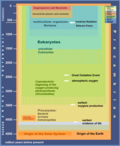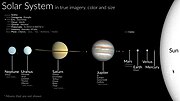 | Planetesimals /plænɪˈtɛsɪməlz/ are solid objects thought to exist in protoplanetary disks and debris disks. Believed to have formed in the Solar System... 11 KB (1,152 words) - 06:33, 19 March 2024 |
 | Nebular hypothesis (redirect from Planetesimal theory of planetary formation) possible. The grains eventually may coagulate into kilometer-sized planetesimals. If the disk is massive enough, the runaway accretions begin, resulting... 75 KB (9,132 words) - 21:19, 18 March 2024 |
SDSS J1228+1040 b is an extrasolar planetesimal orbiting the white dwarf SDSS J1228+1040. It was discovered in 2019 using the variable calcium Ca II emission... 5 KB (505 words) - 19:32, 21 April 2024 |
The Chamberlin–Moulton planetesimal hypothesis was proposed in 1905 by geologist Thomas Chrowder Chamberlin and astronomer Forest Ray Moulton to describe... 2 KB (342 words) - 11:54, 30 November 2023 |
 | Planetary migration (section Planetesimal disk) or other body in orbit around a star interacts with a disk of gas or planetesimals, resulting in the alteration of its orbital parameters, especially its... 40 KB (5,112 words) - 22:08, 13 April 2024 |
resonance chain is broken, the five giant planets undergo a period of planetesimal-driven migration, followed by a period of orbital instability with gravitational... 69 KB (8,537 words) - 20:36, 18 April 2024 |
 | particles, ranging from centimeters up to meters in diameter, into planetesimals in a protoplanetary disk that is enhanced by aerodynamic drag from the... 22 KB (2,790 words) - 01:57, 21 April 2024 |
 | these planetesimal encounters shift (migrate) the orbits of the planets by significant amounts. This process continues until the planetesimals interact... 47 KB (5,828 words) - 05:34, 9 April 2024 |
 | Protoplanet (section The planetesimal hypothesis) kilometer-sized planetesimals that gravitationally perturb each other's orbits and collide, gradually coalescing into the dominant planets. A planetesimal is an... 24 KB (2,339 words) - 02:30, 16 April 2024 |
 | planets, and, indeed, a large number of planetesimals formed there. As with the terrestrials, planetesimals in this region later coalesced and formed... 112 KB (13,449 words) - 15:32, 5 April 2024 |
 | The Solar System has unique planetesimal systems, which led the planets to have near-circular orbits. Solar planetesimal systems include the asteroid... 24 KB (2,683 words) - 07:03, 1 April 2024 |
 | been further developed using intensive numerical simulations to study planetesimal accumulation. It is now accepted that stars form by the gravitational... 39 KB (4,340 words) - 00:16, 28 April 2024 |
 | asteroid belt formed from the primordial solar nebula as a group of planetesimals, the smaller precursors of the protoplanets. Between Mars and Jupiter... 82 KB (8,765 words) - 04:20, 11 April 2024 |
 | TRAPPIST (redirect from Transiting Planets and Planetesimals Small Telescope) The Transiting Planets and Planetesimals Small Telescope (TRAPPIST) is the corporate name for a pair of Belgian optic robotic telescopes. TRAPPIST–South... 7 KB (698 words) - 00:55, 26 January 2024 |
 | Beta Pictoris (section Planetesimal belts) be imaged around another star. In addition to the presence of several planetesimal belts and cometary activity, there are indications that planets have... 57 KB (6,099 words) - 22:44, 2 February 2024 |
interactions with planetesimals originating in an outer disk drive a slow divergent migration of the giant planets. This planetesimal-driven migration... 103 KB (13,549 words) - 03:08, 3 March 2024 |
solar nebula and circumplanetary disk dynamics, the origin of the moon, planetesimal formation, planetary ring dynamics, and martian obliquity variations... 200 KB (445 words) - 18:44, 8 April 2024 |
streaming instability is a hypothetical mechanism for the formation of planetesimals in which the drag felt by solid particles orbiting in a gas disk leads... 62 KB (7,642 words) - 18:48, 27 September 2023 |
 | called the Öpik–Oort cloud, is theorized to be a vast cloud of icy planetesimals surrounding the Sun at distances ranging from 2,000 to 200,000 AU (0... 56 KB (6,188 words) - 20:27, 16 April 2024 |











